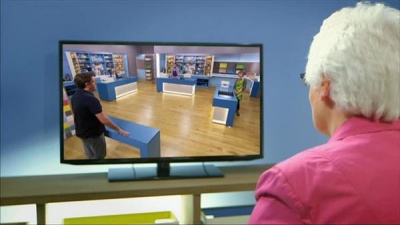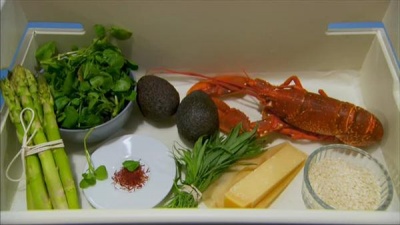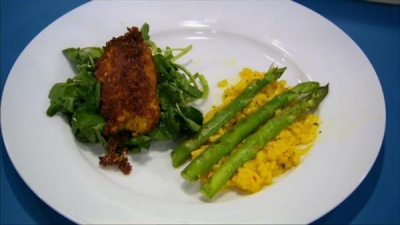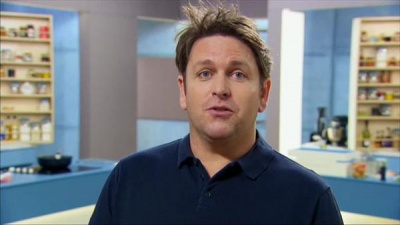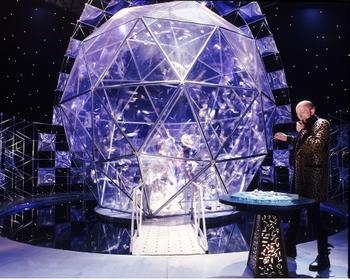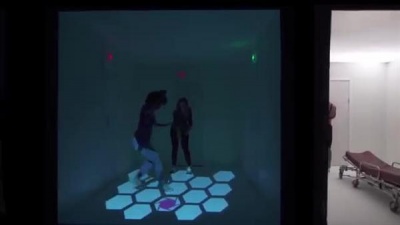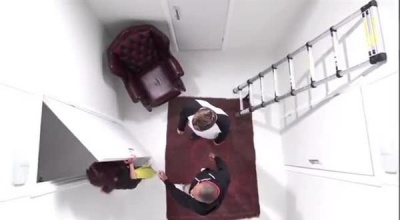Weaver's Week 2015-06-28
Last week | Weaver's Week Index | Next week
When confronted with a box of ideas, and no script, what can creative folk do? The world likes the idea of The Crystal Maze, but what of the implementation? And we look at Hyde, a newer project hoping to unlock its crowdfunding target.
Contents[hide] |
The Box
Shine Soho for BBC1, 25 May — 26 June
Regular readers know that this column tends to ignore cookery shows. We don't write about them because they don't entertain us, and we find them very samey and repetitive. We choose not to inflict this tedium on our reader. So the mere fact that we're writing about a cookery show is a significant fact in itself. Either it's very bad, or it's caught our imagination in a good way.
Why does The Box work? It doesn't mess about, it uses every second of its 29 minutes on air. James Martin is the host, and he explains the basic idea very quickly. Here is a box, a food box, with some exotic ingredients. Three amateur cooks will use the contents of the box, and the contents of an adequate larder – flour and salt and sugar, but not raisins and lasagne, and certainly no recipe books. The chefs receive a basic introduction, just enough to whet the appetite. James will talk to them more during the show proper.
But first, we meet the day's guest. This person could be a celebrity chef, it could be a celebrity such as Alex Jones from The One Show. The guest has prepared a box of ingredients, allowing the players to prepare a dish from their memory, or of their invention. James circles the players, offering some advice (use a blowtorch to ease the skin off a pepper) and engaging in some chatter (you ran three marathons in a week). All the while, the guest is sat in a side room, watching the players cook on a television circuit.
The first dishes are prepared in 50 minutes, and judged by James and the day's guest. All three players have the same initial ingredients, their creativity and skill are compared. Almost as much time is given to the judging as to the cooking, the judges have opinions and share them, and the programme keeps up a good pace – it moves, but it doesn't race away from us.
Winner in this activity gets to pick from three new boxes, each different. One day might have meat, vegetables, and pudding. Another day might have global, leftovers, and nuts, another could have basic, shellfish, and bird, and there's a posh box. The winner picks their own box, and assigns the other two boxes to the other two players. They might be able to choose tactically, playing to the opposition's weaknesses, but with so few options on the day there's little chance.
Again, 50 minutes to make the best dish from the available mains. The vegetables box might contain mushroom and goat's cheese, which is obviously pointing towards a certain dish, but what's to be done with the onions and fruit? A chutney? James prepares these boxes, and usually leads the players to a certain dish – with the ingredients for a cheesecake, will the cook make a cheesecake, or will they go for something else.
This time, James and the guest circulate while the cooks are making their dishes. They give more tips on how to prepare mashed potato – it's done when it just sticks to the spatula. Jeopardy is introduced – will the cheesecake be set, will the chutney be able to chut, will anyone know what a cassolet is when it's served? The best of these second dishes is the winner, and the chef takes home the Cook of the Day award and a small box as a memento.
The Box encourages cooks to experiment, to push their limits. All of the players have good knowledge before entering the studio, they knew some of the ideas and came with some unusual ones of their own – strawberry and black pepper surprised James and a professional chef. And it encourages the viewer at home to take some raw ingredients, add the contents of their larder, and experiment a little. If it all goes horribly wrong, there's always the chippie.
The programme is shot in a bright studio, using fixed cameras. Nothing wobbles, nothing rotates, there are no fancy shots. We might get extreme close-ups of the food, but there's scarcely a zoom or even a pan in the entire show. Craig Harman is the Director of Photography, and we applaud this minimalist approach. There's also a reduction in the amount of music used on the programme: it's there for the tense bits, before finding out the winner, but much of the programme plays out without music, letting James and the cooks converse easily.
And the restraint shows elsewhere. Invention comes from the players, who take food and make freeform meals out of it. Improvisation in the kitchen, but James doesn't use such fancy descriptions. It's some people cooking food, picking up useful tips they can use, demonstrating useful ideas that the viewers can use. They mention how players aren't allowed to consult recipe books, but they mention this once, in the first minute.
They could have had James bang on about how The Box was cuisine jazz, They could have reminded us every five minutes that Delia Smith's Cookery Course was not allowed in the studio. They could have distracted us with a banging soundtrack and artsy zoom-fade-cuts. They didn't do any of these things.
They could have made this show last half-an-hour on a commercial channel, long enough for the celebrity round to make sense – we sometimes think the cooking element is a bit too rushed. They could have made this an hour on a commercial channel, but the ten minutes of padding would have been obvious. They didn't do any of these things.
Let the cookery, and the cooks, be the stars of the show. Just step back. Don't try to over-produce, don't try to control. The art of good cooking is knowing when to stop, when to serve the dish and stop faffing about with it. The Box knows its limits, and serves up unpretentious and wholly satisfying television.
The Crystal Maze
Somewhere in London, This Autumn
The Crystal Maze has won a crowdfunder in eight days flat. Teams of eight, plus the canonical one hour, leads to a concern that players will see two games. Two thoughts on this, not mutually exclusive.
1) We play more than four games per zone. The show was 50 minutes without adverts, about 11 minutes in each zone, so only room to play three or four challenges. We're told that the full experience will be about an hour longer. The teams could play for at least 15 minutes in each zone, and then move on. 15 minutes allows a team to play five, maybe six games. And it allows the backroom staff a little more time to reset the games.
2) Multi-player games in the Fort Boyard style. As not seen on British television, but very much part of the fabric elsewhere.
We expect the construction to be sympathetic to the original, though not pinpoint accurate. A well-lit Aztec zone, a dark and cobwebby Medieval world, a run-down factory, a spaceship. They don't have to have the same layout as the 1990s set, don't have to have the same number of cells.
How will they handle lock-ins? An additional goal is to have a central prison, allowing prisoners to escape. Failing that, a lock-in cage somewhere in each zone: the player is visible, and will move with their team, but can't do much to help.
We hope the designers don't repeat too much from The Crystal Maze television show – the iconic games are Mumsey, and the murder mystery, and one of those is a faff to reset. We're less concerned about games from Fort Boyard, Zodiak owns the rights to both shows, and many of the physical-to-skill games are a) novel to most players, b) easy to explain, and c) quick to reset.
They need to be careful to get the jeopardy right: Fort Boyard Ultimate Challenge was fine for CITV, but not for an adult audience, because they didn't do lock-ins. The French version goes too far the other way, forcing every team to have a lock-in so they can justify Blanche's appearance fee.
This column looks forward to playing in The Crystal Maze in the autumn. But what about people who can't get to London? Sadly, don't expect much.
The site rules prevent teams from making their own recordings of the event. Perhaps this is to help people concentrate on the challenges. Perhaps they're going to mount cameras in each room and sell copies of "your time in The Crystal Maze" to the teams, and then "watch our time in The Crystal Maze" on video sites.
At the risk of stating the obvious, the television programme was built around the demands of television. Camera angles, lighting, sound and microphones, the game construction – all of these elements were optimised for the viewer at home, not the players. This theatre experience is built for the participants. No need to think about cameras, it doesn't matter if the game looks dull on the monitor screens because it's played and then finished.
There may be some footage from testing, and used for promotional purposes. If they're recording the best bits of teams, and the footage is of decent quality, we may well see a highlights show somewhere around Christmas. But this is going to be an event to experience and enjoy. We're looking forward to it.
Hyde
Somewhere in London, Next Spring, Maybe
We're also looking forward to Hyde. It's a bio-logical maze, from the creative people at Slingshot. Here's the backstory:
- "You're taking part in experimental trials of a new drug developed by the Jekyll Corporation. It's designed to modify the capabilities of the human body, giving you the power to control your environment simply by controlling your physical state (your pulse rate, breathing, posture etc).
- "Armed with some wearable tech your assignment is to navigate your way though a maze of connected rooms, using your new powers to complete a series of increasingly challenging tasks along the way.
- "But this is a smart maze: it knows where you are, and how you're doing. You begin to realise that someone – or something – is working against you. You'll need to stay calm to retain control of your surroundings. Because there's only one way out of this maze, and that's through it..."
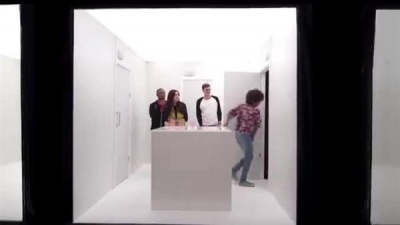 A series of chambers separated by locked doors. There is nothing like a locked door to make a cat curious about what it is like behind it.
A series of chambers separated by locked doors. There is nothing like a locked door to make a cat curious about what it is like behind it.
Some of the doors are opened by completing simple tasks: follow a sequence of lights, or find the hidden switch. Other challenges are completed by your own body: open the door by holding your breath, or lowering your heart rate. Ah! Something very new, we're not going to get that experience elsewhere.
Slingshot describe Hyde as "Crystal Maze meets Portal in the real world"; it's a challenge to make progress, and an unseen hand is working against you. There may even be cake. {1}
The creators are open about what they know they can do, and what they don't know. Messrs Evans and Johnson have been working on this idea for some years – an email about their plans for 2013 intrigued us with this idea.
We can be sure that the game will be safe. Slingshot are responsible for 2.8 Hours Later, the zombie sprint game bringing the undead to the streets of your city{2} since 2010. During that time, they've scared almost 100,000 players witless. Some of them may actually have completed the game without being caught. Everyone has seen sunrise the next morning.
And we can be sure that the game will be scary. Slingshot's hallmark is to bring horror tropes to the outside world. This isn't everyone's cup of tea, and the introductory video gives fair warning. There is nothing like a locked door to make a cat curious about what it is like behind it. Curiosity pursued the cat, shouting loudly and waving something threatening.
Hyde isn't for everyone. It is experimental, it's pushing the boundaries, it might be disturbing, it's likely to break new ground. None of these descriptions apply to The Crystal Maze: from the moment we heard about the idea, we knew roughly what the end product was going to be. We have an inkling about what Hyde will be, but the end result will surprise us.
That's if we ever get to see the end result. Like The Crystal Maze, Hyde is being crowd-funded. As with all crowdfunding ideas, this column encourages caution. Stop and think for a moment. You may not get value for money, and you may not get anything at all. Can you afford to spend this money and see nothing in return? Especially as the target of £50,000 looks out of reach at the moment; through very unfortunate timing, two projects are drawing from the same well of money at the same time.
As well as advance tickets, it's possible to be a real-life lab rat and help to develop the game. People with lots of money and an interest in game design might choose the "Mad Professor" option, experiment with body tech and transfer the knowledge to other projects. And if we all have a look behind the sofa, we might find money to hire out the entire maze for a night.
The Crystal Maze plays to nostalgia. Hyde is cutting-edge technology. We dearly want both of them to work.
More: http://www.kickstarter.com/projects/hyde/hyde-0
{1} Excellent, lucky, or rich players gain access to the "Soho Rooms" at the heart of the maze. Is that a cunning euphemism for "cake shop"? We'll have to find out.
{2} Except Plymouth, much to the chagrin of everyone involved.
This Week and Next
One matter left hanging from this week's Counterpoint: the Sabre Dance comes from "Gayane".
BARB ratings in the week to 14 June.
- The Eastenders was the most-seen show at 7.25m. Then came The Syndicate (6.5m) and The Interceptor (4.75m), but both were dramas nicking the title of iconic game shows.
- Which means the top game show was Who Dares Wins, on 3.95m viewers. It was a memorable episode, contestants were asked for Christmas carols (in mid-June!) and suggested Nigella Lawson was on the BBC's list of gentleman chefs.
- Famous Family Fortunes had 3.15m, The Cube came back to 2.55m, Catchphrase to 2.4m, and three episodes of The Chase were seen by 2.06m.
- Mock the Week had 1.6m viewers, Big Brother 1.4m, and Catsdown 800,000.
- A League of Their Own topped the new channels list with 690,000, and "Celebrity" Love Island 490,000. Rupaul's Drag Race on TruTV? 60,000.
Missing from the BBC1 top 30, Prized Apart. We expect to give a review of this show next week. Before then, Big Brother (C5, 5*, MTV, TV3, 3e) goes through the bottom of its creative barrel with an eighties week. Great news for the viewers' parents. Good week on radio: a Fighting Talk special (Radio 5, Sun), Miles Jupp says It's Not What You Know (2) (Radio 4, Tue) with Richard Osman and his mother. If you wanted to know what Ejector Seat looks like with sign language, set your video for Thursday morning on ITV. And if you want to see Fort Boyard in French (and maybe some The Crystal Maze hints), TV5 next Saturday for the 2014 series.
Photo credits: Shine Soho, Chatsworth / Channel 4, Slingshot.
To have Weaver's Week emailed to you on publication day, receive our exclusive TV roundup of the game shows in the week ahead, and chat to other ukgameshows.com readers, sign up to our Yahoo! Group.


